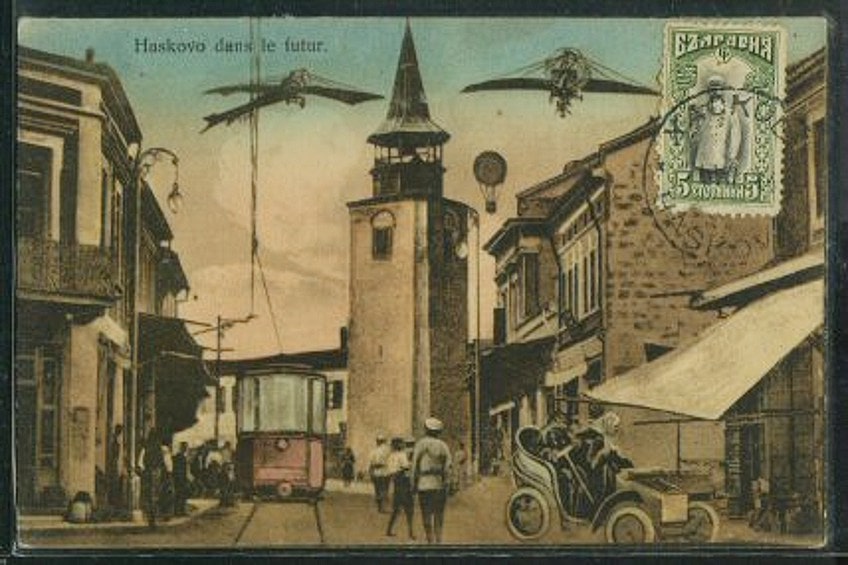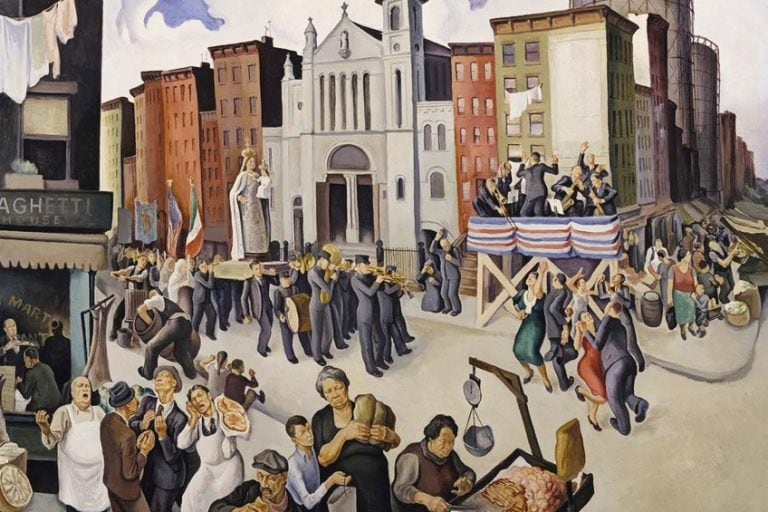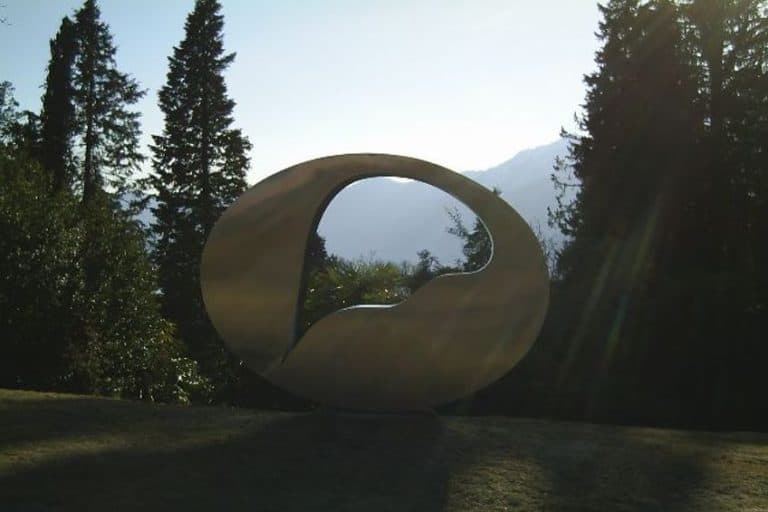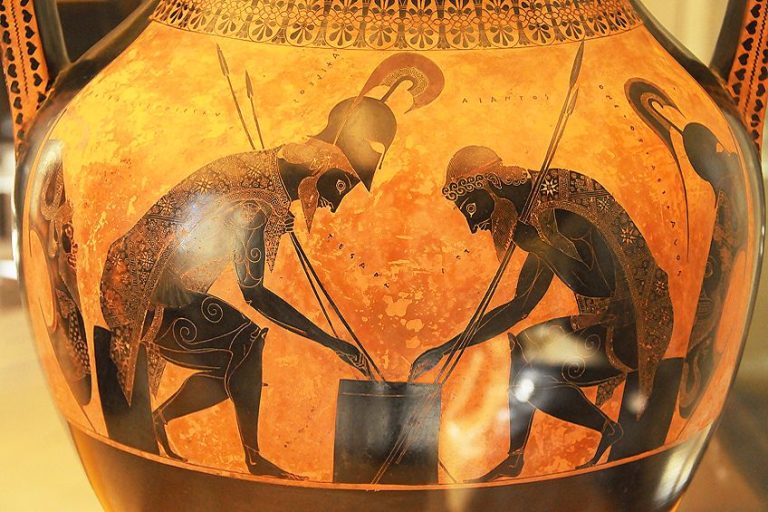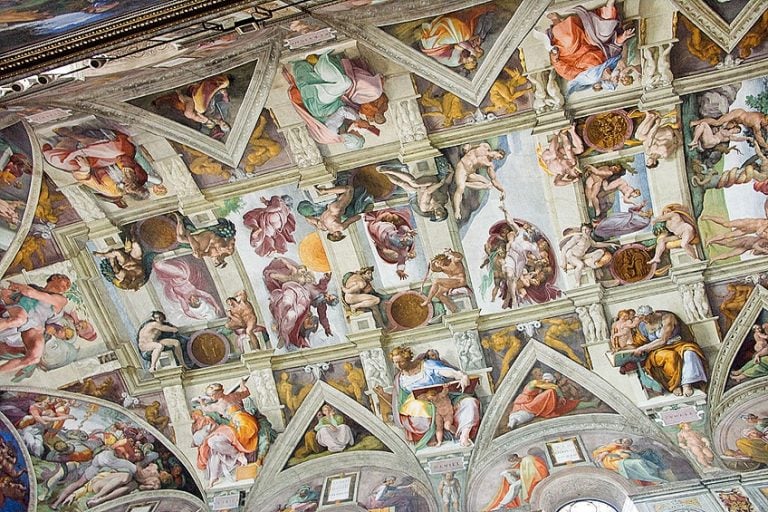Retrofuturism – Taking a Look Back at Retrofuturistic Art
If you take the future and add a bit of retro to it, you will have what we refer to as “Retrofuturism”. If you have ever watched the movie Back to the Future and remember Marty McFly’s quite retro, futuristic hoverboard, you will get a glimpse of what this cultural movement is all about: going back to the past, which in turn, looks at the future. That might sound confusing, but we promise that this article will provide some explanation.
What Is Retrofuturism?
So, what is Retrofuturism? Simply put, it was a 60s futurism movement that looked at how the imagined future would have looked like for people during and prior to the 1960s (think of it as us looking at people from the past, who are looking back at us, who are from the future, or our present moment).
It could have been through various media like television, images, films, science fiction and non-fiction literature, Retrofuturism design, and architecture in the form of flying cars or monumental skyscrapers, to name a few retrofuturistic examples.

It is important to understand the differences between the terms “Retrofuturistic” and “Futurism”, because they have different characteristics. The art movement of Futurism started around 1909 in Italy. Various artists and writers who were influenced by the technological developments from the Industrial Revolution imagined the world or the future.
Their art and core tenets of the movement influenced many other cultural movements in history.
Below, we aim to provide a definition of this cultural movement by looking at some of the originating sources of the term. We will also discuss two “trends” that define this cultural genre, namely one that is from the past and one that is from the present, and touch on some of the sub-genres that have developed as a result.
Defining “Retrofuturistic”
The dubious origins of the term indicate that it was first used by Lloyd Dunn in 1983 as presented by the Fringe Art Magazine (1988 to 1993). Other indications mention it was also utilized by the author T.R. Hinchcliffe in his book titled, Retro-futurism (1967), which was published by Pelican Books. However, there are various sources that indicate the book does not exist and some sources provide evidence that it does.

The Two “Trends” of Retrofuturism
The first trend describes Retrofuturism from the vantage point of the past, how people from the past perceived the future. This was during the period before the 1960s, we can also say it was the 1950s futurism or 60s futurism.
Various artists, writers, scientists, and filmmakers created images and designs based on a Space Age-like future, which has also been described as a utopian world.
This vision of the future was, in part, a serious observation – or postulation – as well as a pop-cultural phenomenon widely seen in television, illustrations, and various other media of the time. The ever-expanding new age of technology and science during the 1900s was a strong influencing factor to how people saw life and, inevitably, how they imagined the future would turn out.
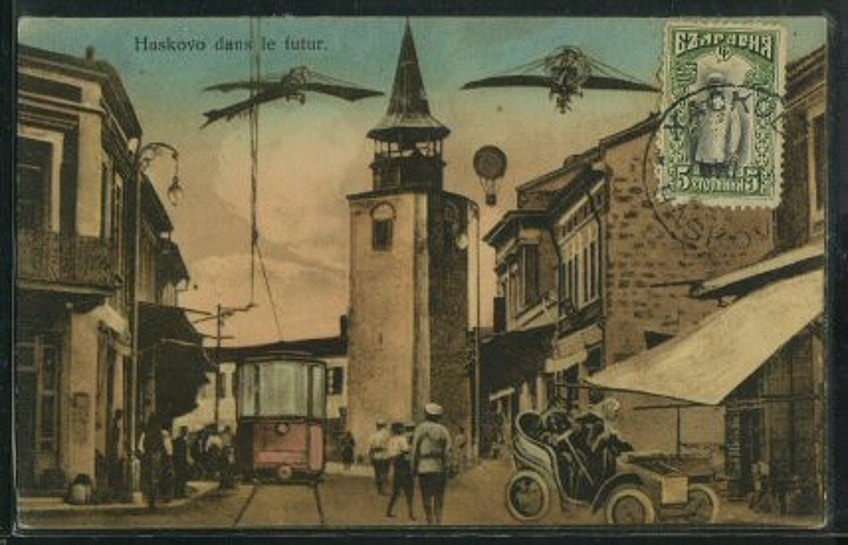
The second trend describes Retrofuturism from the vantage point of the future (our present). It looks back at the “retro” styles of the past and incorporates those styles into a futuristic new style, in other words, it combines the old with the new, taking inspiration from the old.
This also branches out into the popular Steampunk genre, which draws inspiration from the Victorian era, or the Cyberpunk genre most of us have heard about.
While both trends seem like separate ideologies to some extent, some of the primary and contributing themes arising from them are nostalgia of a time past and a time envisioned. Additionally, the idea of a more utopian world where everything is easy and as highly advanced as it can be (often to an unrealistic degree) points to a time where people may have also felt a sense of “dissatisfaction” with their present environments.
Retrofuturism Genres
There are several sub-genres that have developed from the Retrofuturism genre. These are the above-mentioned Steampunk and Cyberpunk genres, but others include Atompunk, Dieselpunk, Decopunk, and Raygun Gothic. Each genre typically centers on technological advancement in historical times, also indicated by its name.
Briefly, when we look at Steampunk, it centers on the Victorian era’s style and the age of steam. Cyberpunk originates from Science Fiction novels (for example Philip K. Dick) and centers on more dystopian realities that explore a world where cyber technologies are highly developed, but society is in ruin.
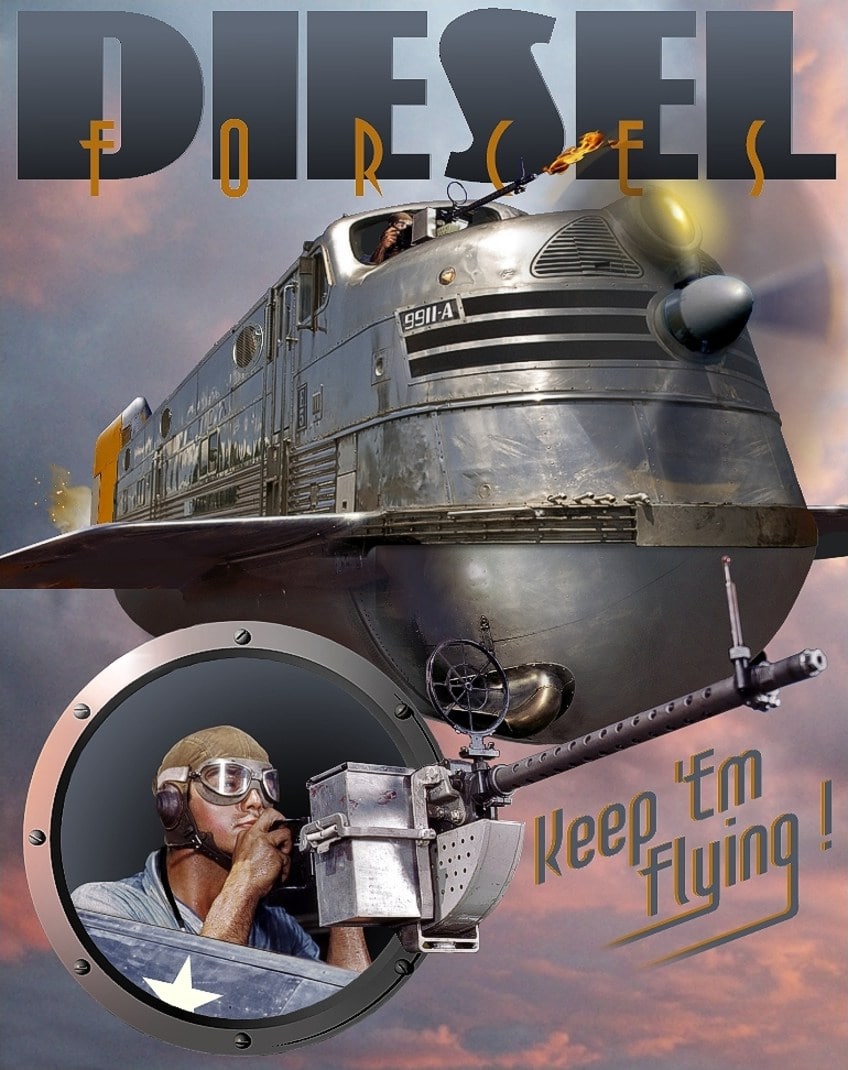
Atompunk revolves around the time from 1945 to 1965, often described as the pre-digital age, it is like Dieselpunk, which occurred during the time of World War I to the 1950s. It refers to one of the primary technological advances, diesel, utilized during the time in transportation.
Other sub-genres include Deco Punk, which also occurred during the same time, however, its style derived from that of Art Deco and other styles prevalent during the 1920s. Raygun Gothic similarly included styles from Art Deco, the 1930s Streamline Moderne, and the futuristic-styled architecture of the Googie style.
Retrofuturism Art
Retrofuturism art spans across illustrations, film, television, literature, fashion, architecture, music, video games, consumer products, domestic life, advertising, and design. It has been applied to numerous types of artworks that express its, sometimes described as “exaggerated”, qualities.
Not only does this genre of visual arts and design show us the creative and progressive thought from the past, but it also shows us that some of the past-future creations were not that far from reality and can be seen in our present-day world.
Below we look at some of the different types of Retrofuturism art from both the first and second trends mentioned above. From steam engines with a modern twist to twisting rocket ships and everything in between.
Let us first explore some of the common features related to this 20th-century pop-cultural phenomenon.
Retrofuturism Art Characteristics
The Retrofuturism design is easy to distinguish, some of the common features related to this have been touched on above, for example, flying cars or monumental skyscrapers – the Space Age look. The outside environment appears highly developed, architecture is streamlined, the colors are described as “solid”, and it is built on large scales.
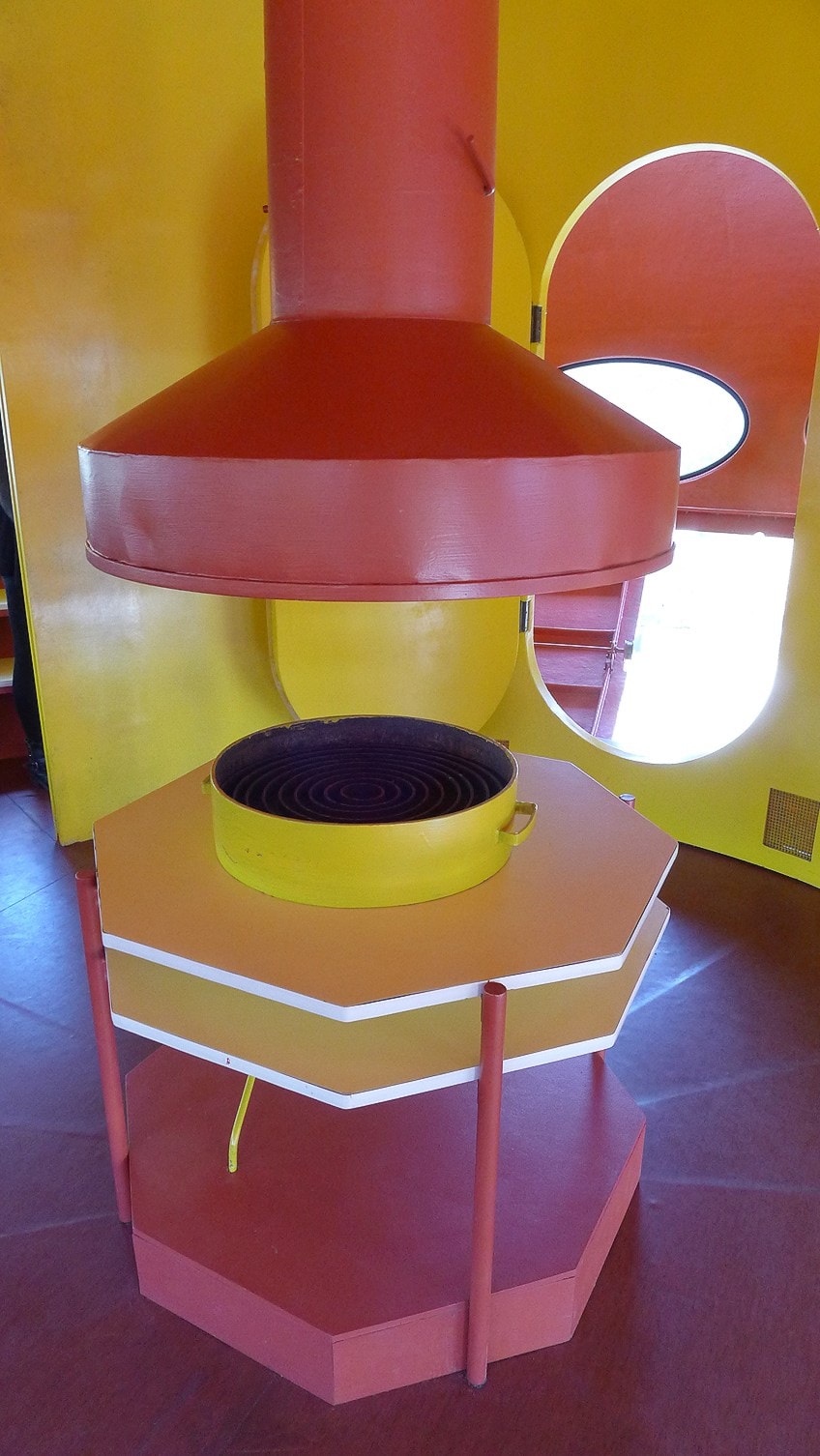
When we look at Retrofuturism fashion trends, a commonality between both male and female outfits is the one-piece and tight-fitting, uniform-like outfits with accompanying space-age boots. Clothing is often made from plastic (PVC), which gives it a futuristic feel.
Beyond architecture and fashion, what underpins most of Retrofuturism art is the curvy, pointy, clean, minimal, and almost electric appearance of objects and machinery, which is portrayed in most of the visual arts of this period.
Retrofuturism Architecture
The Googie style was a common architectural style during the 1940s to 1970s. It was widely seen in motels, gas stations, and various restaurants in America. The term originated from the coffee shop called the Googie Coffee Shop (1949) in Los Angeles, designed by John Lautner.
What characterized this style of architecture was a focus on geometric shapes like triangular forms, an emphasis on curving forms, and what is described as “upswept” roofs, which simply means that roofs had an angle that faced upwards. The “tailfin” is another description that marked this style.
Other materials used on the Googie-styled buildings included metals like steel, glass, plastic panels, and neon. The “Starburst” is also a common feature added to Googie buildings to indicate ornamental qualities and a sense of flashiness, an example of this is the welcoming sign in Las Vegas, reading, “Welcome to Fabulous Las Vegas”, here we will notice the ornamental star accompanying the sign.
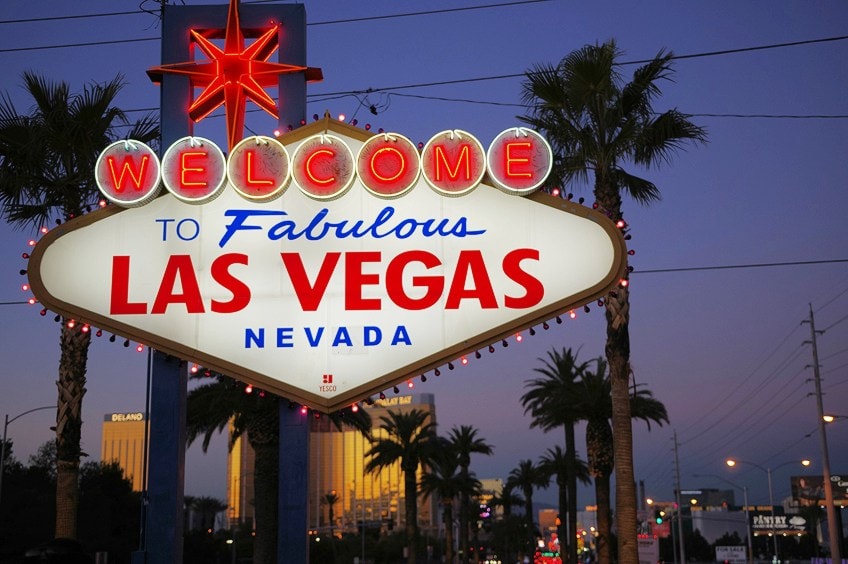
Another example of this style of building is Johnie’s Coffee Shop (1956) in Los Angeles, on the corner of Wilshire Boulevard and Fairfax Avenue. It was built by architects, Louis Armét and Eldon Davis. We see the characteristic neon light bulbs making the signage of the restaurant in front with bands of blue and white as the building’s color scheme. The roof also slopes, giving the restaurant dynamism.
What is notable about many of these restaurants is the buildings were often dynamic in appearance – they were built to give the feeling of movement, and coupled with its futuristic designs it was reminiscent of a spaceship, which is dynamic in nature. This is also referred to as the “boomerang” design feature.
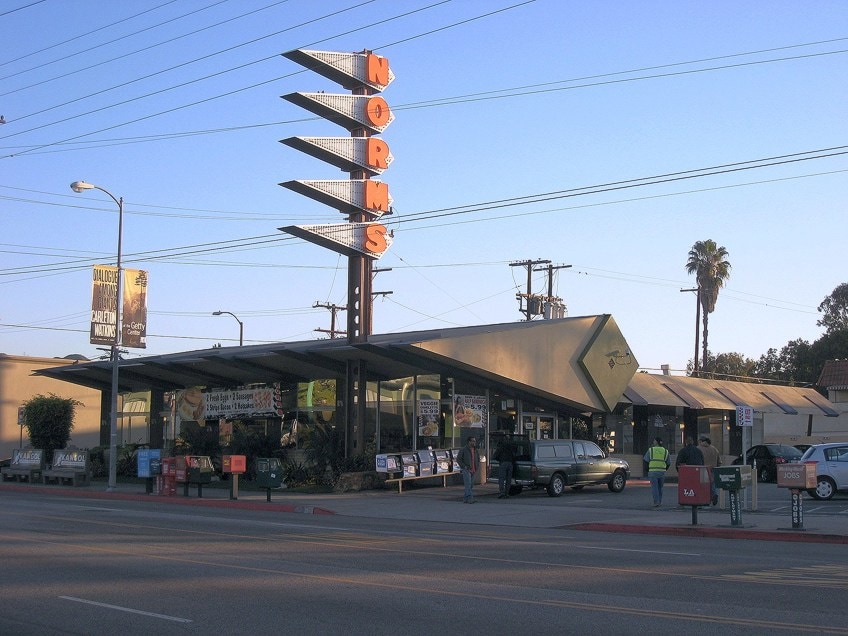
Other examples include Pann’s Coffee Shop (opened in 1958), also in Los Angeles, in the Westchester neighborhood. It too scores the neon signage and has been featured in several films. There is also Norms Restaurant (founded in 1949), which is in various regions in California.
The style of Norms Restaurant depicts the classical angular shapes appearing like triangles as well as an eye-catching neon sign where each letter of the name, “Norm”, is on the base of a sharp protruding pointed shape.
Other designs include motels, for example, the Caribbean Motel (1957), which is part of New Jersey’s Wildwoods Shore Resort Historic District. This motel was built by Lou Morey, who also built various other motels as part of the resort motels, in another style called the Doo-Wop style, which was like the Googie style mentioned here.

When we look at the Caribbean Motel, we will notice the reminiscent Space Age shapes, namely, a suspended ramp, otherwise described as a “levitating ramp”, panels of glass walls, and a flashy neon sign with the name of the motel decorating the top of the building. The overall appearance of the motel looks like something from another age, something more modern than what everyone was used to at the time.
Television shows like “The Jetsons” also popularized the Googie style, which was a precursor to the Retrofuturistic style.
We will notice other forms of futuristic architecture from concept art illustrations, for example, the cover from the Science and Mechanics Magazine (1931) depicts a futuristic urban metropolis none other than New York in the year 2032. We see monumental scale buildings lavishly decorated in massive statues with significant landing spots for airplanes and other flying vehicles.
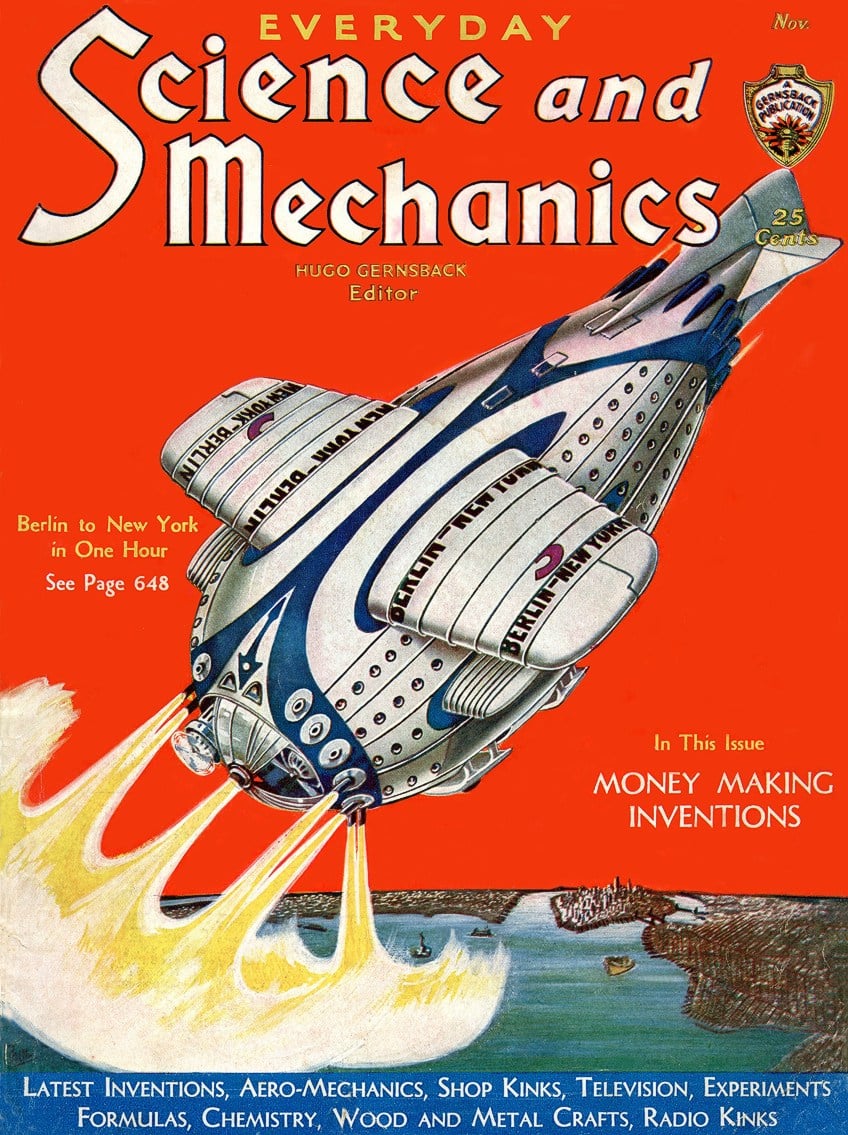
The Los Angeles International Airport built its Theme Building (1961) reminiscent of a spacecraft. It is a white building with two semi-circles appearing to overlap one another, these are four concrete (reinforced with steel) arching legs, giving the building four “legs” to stand on, almost like it just landed from space.
We also notice blue lights lighting up the inner hollow of the structure, giving it an almost otherworldly appearance.
Another famous example is Walt Disney’s Tomorrowland, which is a famous theme park in various cities worldwide. Tomorrowland opened for the first time in 1955 and its TWA Moonliner structure was one of the initial exhibits in the theme park and was over 70 feet tall.

Retrofuturism Objects and Designs
While there is a large collection of retrofuturistic architecture and concept art, what is also worth noting is the vast selection of objects invented that relay the message of the future, quite literally. One example is the telecommunications video advertisement from a British company called the BT Group.
In this advertisement, they suggest a new visual telecommunications tool that will allow people to work from home, and no longer need to go to the office. People will be able to do video conferences with one another from any country in the world. Along with this new video technology, people will also be able to make photocopies of scanned documents.
These futuristic notions from the early to mid-1900s were not far off from what is experienced in our present-day lives.
We will also find similar predictions of technology in the 1980s video ad titled Telefuture. It discusses various components related to how a television set can broadcast from multiple streams, very similar to our technology today of streaming online programs through our “Smart” television sets.
Retrofuturistic Travel
The idea of travel is another important part of Retrofuturism. Throughout most Retrofuturism art we will find the enhancement of all things to do with travel, as well as the idea of travel being done at a fast and effective speed.
Concept art in the form of illustrations depicts cars, airplanes, boats, and trains that have a futuristic twist.
Examples include the Shonen Club, which was a Japanese Magazine. The magazine provided illustrations from the World Transportation Invention Competition in 1938, which were done by various inventors. Such inventions include the Mountain Monorail (1936) by Kikuzo Ito and the Sphere-wheeled Car (1936) by Reiji Iizuka. The mountain monorail is depicted as a red train-trolley-airplane vehicle. It is moving at a fast speed along a single train track, however, it is balanced on the track and kept in motion by only two metal disc-like wheels.
There is an airplane propeller on top of the train and a fin located near the back part of the top, this is what gives the train its airplane character and enhances the idea of speedy travel. The train itself appears very streamlined and thin in the structure; it is also embellished with a sleek silver metallic cover wrapped around the front.
We will notice another red train in the background coming from the train track, which is winding its way through a mountainous region.
There are also people traveling inside appearing to marvel at the astonishing height they are traveling at, which is indicated by the seeming never-ending depth only put in perspective by the rising white mists from below, which complements the white of the thick circular columnar structures supporting the train track.
The Sphere-wheeled Car similarly has unique features that assist its effective travel and speed as the above vehicle, however, with this one we notice large ball-like tires instead of the regular, less futuristic, four wheels. There is also only one large tire ball (or is it ball-tire?) at each end of the car, with what appears to be a smaller one in the center.
We also notice someone driving the car, with white wisps of air here and there indicating the driver is speedily on his way somewhere.
More Retrofuturism Art
The film, Sky Captain and the World of Tomorrow (2004), is another example of Retrofuturism. Made in 2004, the story is set in 1939 in New York, which is invaded by robots – a classical futuristic storyline – and the main characters are set to fight a German scientist.
Other examples include the 1985 science fiction film, Brazil, which centers on a world where people live in a dystopian reality because of extreme industrialization and over-consumption. The 1982 movie, Blade Runner, is an example from the Cyberpunk genre, exploring another dystopic world where extreme consumerism and reliance on machines is normal, but most people are unhappy and controlled.
We will also find the Retrofuturist style in more recent pop-cultural modalities like video games, for example, Assassin’s Creed III, Call of Duty: Black Ops II, Crimson Skies, Cloudpunk, Dishonored, Fallout, Grand Theft Auto 2, Metal Gear, We Happy Few, and X-Men: Destiny.
Back to the Future, Again?
The Retrofuturism world is vast and has been portrayed through almost every medium, from film to fashion. We will find it is an exciting view on the future and all the possibilities of a new age – bringing the ideals of space to the comfort of our own homes, and similarly, bringing the ideals of comfort to our everyday lives in the form of functional conveniences, easier travel, and flashy looks.
It hints at a utopian world, but conversely, it hints at the darker aspects of these utopian ideals. Retrofuturism also depicts the underlying dystopian realities due to extreme progress and the effects of industrialization, which we see in numerous pop-cultural media. Genres like science fiction have portrayed these stories throughout the 20th Century and beyond.
So, what can we make of Retrofuturism? It certainly is like an “Alice in Wonderland – Through the Looking Glass” type of world. We walk in transformed by the somewhat idealistic portrayal of optimism for the future and in turn, we celebrate that optimistic outlook from the past, in the present.
https://www.youtube.com/watch?v=9tj-alKvyx0
Take a look at our Retro Futurism art webstory here!
Frequently Asked Questions
What Is Retrofuturism?
Retrofuturism looks at how the imagined future would have looked for people before the 1960s. There are two main “trends” that define this movement, namely, the vantage point of the past, how people from the past perceived the future (1950s futurism), and the vantage point from the future (our present), which looks back at the “retro” styles of the past and creates a new type of style from the past and present combined.
What Are the Genres of Retrofuturism?
Different sub-genres developed under Retrofuturism art, are namely, the popular Steampunk and Cyberpunk genres, and others include Atompunk, Dieselpunk, Decopunk, and Raygun Gothic. Each genre highlights one of the prominent technological advancements from the historical period it emulates, for example, Steampunk emulates the Victorian era when steam was one of the primary technological advancements in transportation.
What Are the Characteristics of Retrofuturism?
Retrofuturism is characterized by Space Age-like motifs, objects, and styles, for example, flying cars or monumental skyscrapers. Retrofuturism fashion usually depicts one-piece and tight-fitting, uniform-like outfits with accompanying space-age boots. Clothing is also often made from plastic (PVC). Retrofuturism depicted in visual arts can be described as curvy, pointy, clean, and minimal in appearance (this relates to architecture, concept art, designs, and other objects related to the genre).
Where Did the Term “Retrofuturism” Originate?
There are several possibilities for the origins of the term, “Retrofuturism”. Many sources indicate that it was first used by Lloyd Dunn in 1983 as presented by the Fringe Art Magazine (1988 to 1993). Other sources suggest it was utilized by the author T.R. Hinchcliffe in his book titled, Retro-futurism (1967), which was published by Pelican Books (various sources suggest the book does not exist and some sources provide evidence that it does).
Isabella studied at the University of Cape Town in South Africa and graduated with a Bachelor of Arts majoring in English Literature & Language and Psychology. Throughout her undergraduate years, she took Art History as an additional subject and absolutely loved it. Building on from her art history knowledge that began in high school, art has always been a particular area of fascination for her. From learning about artworks previously unknown to her, or sharpening her existing understanding of specific works, the ability to continue learning within this interesting sphere excites her greatly.
Her focal points of interest in art history encompass profiling specific artists and art movements, as it is these areas where she is able to really dig deep into the rich narrative of the art world. Additionally, she particularly enjoys exploring the different artistic styles of the 20th century, as well as the important impact that female artists have had on the development of art history.
Learn more about Isabella Meyer and the Art in Context Team.
Cite this Article
Isabella, Meyer, “Retrofuturism – Taking a Look Back at Retrofuturistic Art.” Art in Context. November 29, 2021. URL: https://artincontext.org/retrofuturism/
Meyer, I. (2021, 29 November). Retrofuturism – Taking a Look Back at Retrofuturistic Art. Art in Context. https://artincontext.org/retrofuturism/
Meyer, Isabella. “Retrofuturism – Taking a Look Back at Retrofuturistic Art.” Art in Context, November 29, 2021. https://artincontext.org/retrofuturism/.


